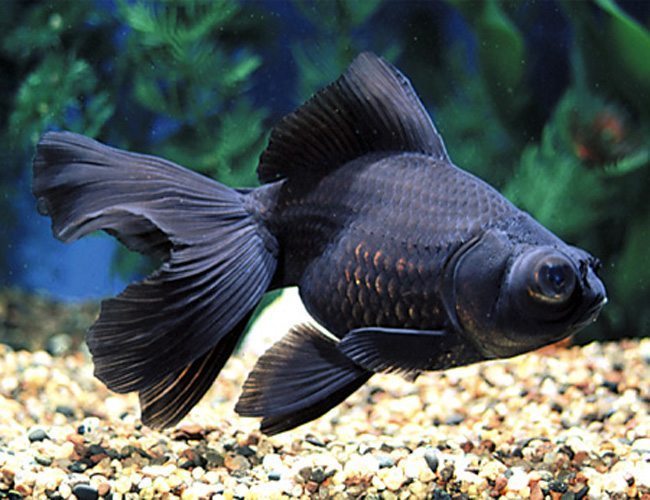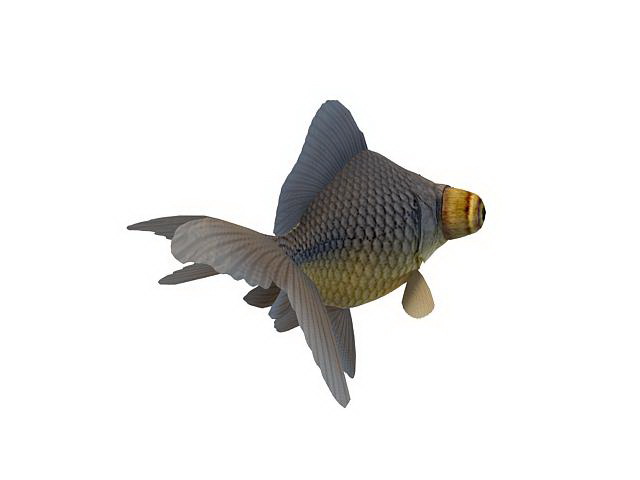

Other than its telescoping eyes and slightly smaller size, a basic Telescope Goldfish is very similar to the Fantail Goldfish. The Telescope Goldfish is an egg-shaped variety of goldfish. IUCN Red List: NE - Not Evaluated or not listed - There are no wild populations of this captive-bred variety.Social Grouping: Groups - Can be kept singly or in groups.Scientific Name: Carassius auratus auratus.Today, domesticated goldfish are distributed world-wide, and the Telescope Goldfish is one of more than 125 captive-bred fancy goldfish varieties. The Black Moor is still referred to as the Dragon Eye Goldfish as well as the Black Demekin. In the later part of the 1700s, it was produced in Japan where it is known as the Demekin. It is believed to have been developed in China in the early 1700s where it was known as the Dragon Eyes or the Dragonfish. The Telescope Goldfish is also known as the Demekin, Dragon Eye Goldfish, and Globe Eye Goldfish. We can see the results of this centuries-long endeavor in the wonderful colors and shapes of goldfish today. The majority of the fancy goldfish were developed by Asian breeders. By the 1500s, goldfish were traded to Japan, arriving in Europe in the 1600s and America in the 1800s.

Goldfish were originally developed in China. However, recent genetic research points to C. This fish has a wide range across the waters of the European continent, running west to east from England to Russia, north to Scandinavian countries in the Arctic Circle and as far south as the central France and the Black Sea. They inhabit the slow moving and stagnant waters of rivers, lakes, ponds, and ditches feeding on plants, detritus, small crustaceans, and insects.įor many years, it was believed that goldfish had originated from the Crucian Carp Carassius carassius described by Linnaeus in 1758. These wild carp originated in Asia Central Asia (Siberia). The goldfish of today are descendants of a species of wild carp known as the Prussian Carp, Silver Prussian carp, or Gibel Carp Carassius gibelio (syn: Carassius auratus gibelio), which was described by Bloch in 1782. Coldwater Fish - Looking for cold water fish? (65 °).Similar size fish - Fish that are 1 inch bigger or smaller.Community Fish - Peaceful Freshwater fish.Beginner Fish - Freshwater fish for beginners.Goldfish Care: Fancy Goldfish and Goldfish Diseases These fish will thrive best housed with the other similarly handicapped fish, including the Black Moor and the less hardy Bubble Eye Goldfish, Lionhead Goldfish, and Celestial Goldfish. Their eyes are also subject to injury and infection. Their eyes cause them to have poor vision, so they are not a good competitor for food. This is not because they lack general hardiness, but because of their extremely telescopic eyes.

Like the Black Moor, the Telescope Goldfish can live at colder temperatures, but unlike the Black Moor, the Telescope are not considered good beginner fish. The well known and very popular Black Moor Goldfish is basically a black version of the Telescope Goldfish, though its eyes don't protrude quite as far. The bi-colored black/white version is affectionately known as the Panda Telescope Goldfish, and one unique chocolate version has orange pompoms. These include solids of red, blue, chocolate, or white tri-colored and calico and bi-colored versions in red/white and black/white. The Telescope Goldfish is available in many different colors in both metallic and nacreous scale types, but seldom in a matte scale type. Today, they are also available with long flowing fins and a couple other tail fin styles: veil tail, broadtail, and butterfly tail. The body is short and stubby with a very wide head and a split caudal (tail) fin that is moderate in length and slightly forked.

It is very similar to the Fantail Goldfish except for its telescoping eyes and slightly smaller size. The Telescope Goldfish is one of the more rounded or egg-shaped fancy goldfish. Later in that century, in Japan, they were given the name Demekin, which the Japanese still call them today. The Telescope Goldfish are believed to have been first developed in China in the early 1700s when they were named the Dragon Eye Goldfish or Dragonfish. On some individuals, these stalks can extend out as far as 3/4 of an inch (19 - 20 cm), but they don't really start to protrude until these fish are about 6 months old. Their large eyes are set on top of long telescope or cone-like stalks mounted on the sides of its head. The eyes are the most curious characteristic of the Telescope Goldfish.


 0 kommentar(er)
0 kommentar(er)
